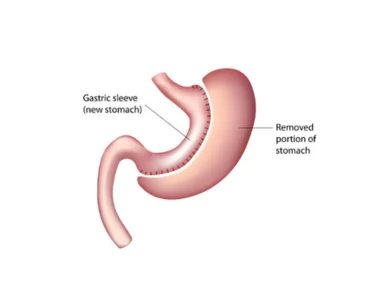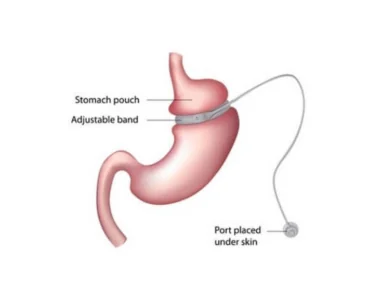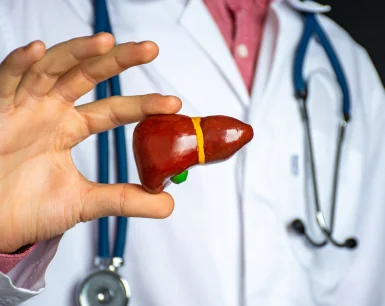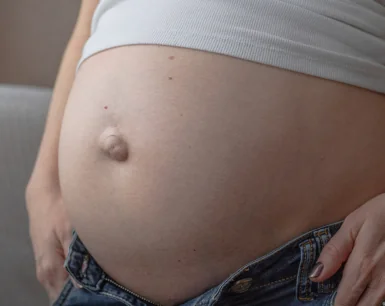When it comes to weight loss surgery, two popular bariatric treatment options are the Gastric Sleeve and the Lap Band (Gastric Band Surgery). Both procedures aim to help individuals struggling with obesity achieve significant weight loss and improve their overall health. However, they differ in approach, effectiveness, and long-term outcomes. In this blog, we’ll explore the key differences between these two procedures to help you make an informed decision.
Procedure Overview
Gastric Sleeve (Sleeve Gastrectomy)

- Involves the removal of approximately 75-80% of the stomach.
- The remaining stomach is a tube-like “sleeve” that restricts food intake.
- Permanent procedure with no foreign objects placed in the body.
- The procedure is performed laparoscopically, using small incisions, which reduces recovery time.
- Reduces the production of ghrelin, the hunger hormone, leading to decreased appetite.
Lap Band (Laparoscopic Adjustable Gastric Banding)
- A silicone band is placed around the upper part of the stomach.
- The band creates a small pouch, limiting food intake and slowing digestion.
- The band can be adjusted or removed if necessary.
- The surgery is less invasive compared to gastric sleeve and is also performed laparoscopically.
- The band’s tightness can be adjusted by adding or removing saline through a port placed under the skin.
Weight Loss Results
Gastric Sleeve:
- Patients typically lose 60-70% of excess weight within the first year.
- Weight loss is rapid and sustained for many patients.
- Studies show that many patients maintain 50-60% of their excess weight loss even after 5 years.
- The significant reduction in stomach size and hormonal changes contribute to long-term success.
Lap Band:
- Weight loss is slower, with patients losing 40-50% of excess weight over a few years.
- Results vary depending on band adjustments and patient adherence to dietary guidelines.
- Long-term studies have indicated a higher risk of weight regain compared to the gastric sleeve.
- Success heavily depends on regular follow-ups and band adjustments.
Surgical Risks and Recovery
Gastric Sleeve:
- More invasive than the lap band but with lower long-term complication rates.
- Risks include leakage, bleeding, and nutrient deficiencies.
- Hospital stay: 1-3 days; recovery time: 4-6 weeks.
- Long-term risks include the potential development of gastroesophageal reflux disease (GERD).
- Nutritional deficiencies, particularly in vitamins B12, iron, calcium, and folate, may occur if supplements are not taken.
Lap Band:
- Less invasive with fewer immediate surgical risks.
- Potential complications include band slippage, erosion, and port-related issues.
- Outpatient procedure; recovery time: 1-2 weeks.
- Requires routine adjustments to maintain effectiveness.
Long-Term Considerations
Gastric Sleeve:
- Permanent with significant long-term weight loss success.
- No need for follow-up adjustments.
- Can lead to nutrient deficiencies without proper supplementation.
- Hormonal changes often lead to reduced appetite and improved metabolic health.
- Less risk of complications compared to the lap band but irreversible.
Lap Band:
- Adjustable and reversible.
- Requires regular follow-up for band adjustments.
- Higher rate of long-term complications and band removal compared to gastric sleeve.
- Weight loss can plateau or reverse if band adjustments are not maintained.
- Band erosion, slippage, or mechanical malfunction might necessitate additional surgery.
Impact on Lifestyle
Gastric Sleeve:
- Major lifestyle changes required.
- Patients must follow strict dietary guidelines and take vitamins.
- Portion sizes are significantly reduced, and certain foods may become difficult to consume.
- Physical activity becomes essential to maximize and maintain weight loss.
- Emotional and psychological adjustments are necessary to cope with the reduced ability to eat.
Lap Band:
- Gradual adjustments to eating habits.
- Ongoing medical follow-up is necessary for optimal results.
- Patients must eat slowly and chew thoroughly to avoid discomfort.
- Band adjustments require regular appointments with the bariatric team.
- Weight loss depends heavily on patient adherence to lifestyle changes.
Psychological and Emotional Impact
Both procedures have significant psychological implications. Weight loss surgery is not just a physical transformation; it also affects mental and emotional well-being.
Gastric Sleeve:
- Patients often experience rapid changes in body image.
- Emotional support, counseling, or therapy might be necessary to adjust to new eating habits.
- The hormonal changes that reduce hunger can also influence mood and energy levels.
Lap Band:
- Weight loss occurs more gradually, which may lead to frustration for some patients.
- Ongoing adjustments and follow-up visits can create anxiety for individuals.
- The presence of a foreign object in the body can be psychologically unsettling for some.
Which One Should You Choose?
The decision between gastric sleeve and lap band surgery depends on your health goals, medical history, and lifestyle preferences. If you’re looking for substantial weight loss surgery with fewer long-term complications, the gastric sleeve may be the better option. It provides faster, more consistent results and requires less follow-up care in the long run.
However, if you prefer a less invasive, reversible procedure with the option to adjust or remove the device if needed, the lap band or gastric band could be more suitable. While it requires more ongoing maintenance, it offers a less drastic initial change and the flexibility of reversibility.
Key Takeaway:
- Gastric sleeve is typically recommended for those seeking significant, long-term weight loss and who are prepared for permanent lifestyle changes.
- Lap band might appeal to individuals who want a reversible option and are willing to commit to regular follow-up care.
Always consult with your GP and a NHS-trusted private weight loss clinic to discuss your options and determine the best approach for your weight loss journey. Bariatric surgery is a life-changing decision, and understanding the differences between the gastric sleeve and lap band can help you choose the path best suited to your needs and goals.





